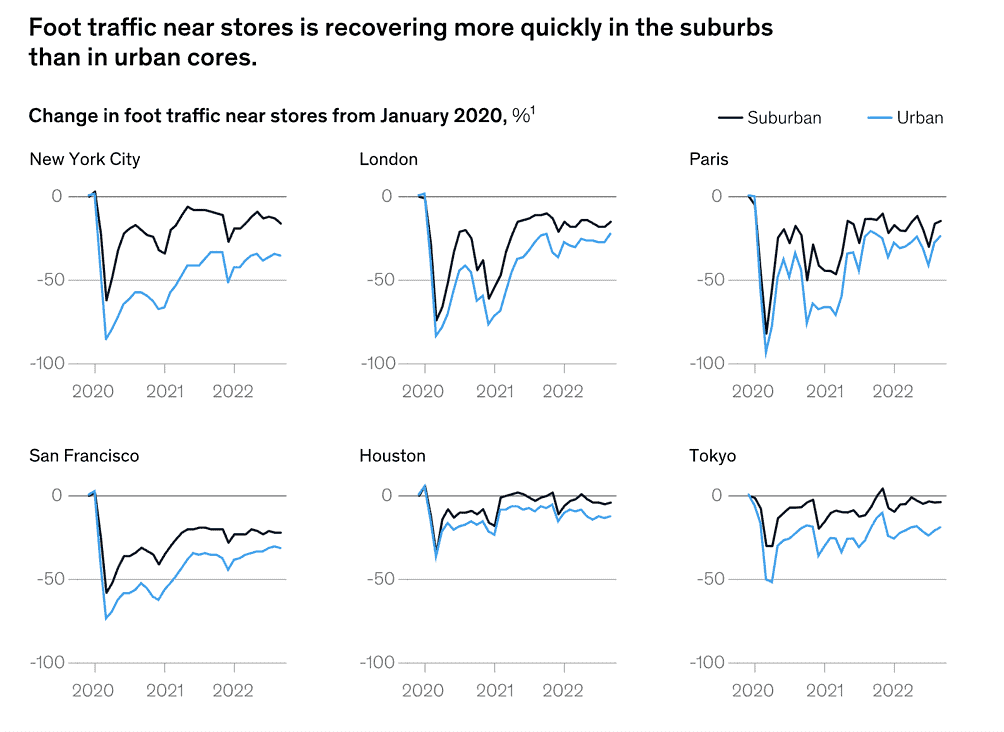
The post-pandemic world has brought about significant changes in how cities function, particularly in real estate. A McKinsey Global Institute report titled ‘Empty Spaces and hybrid places: The Pandemic’s lasting impact on real estate‘ highlights the need for cities to adapt to these changes to maintain their vibrancy and relevance.
- Hybrid work is here to stay, a McKinsey Global Institute report says. As a result, office attendance has stabilized at 30 percent below pre-pandemic norms.
- In so-called ‘superstar cities’, office and retail space demand will remain below pre-pandemic levels.
- Cities and buildings can adapt and thrive by taking hybrid approaches themselves.
The report states that hybrid work is here to stay. “As a result, office attendance has stabilized at 30 percent below pre-pandemic norms.” This shift in work patterns has led to a ripple effect, with residents leaving urban cores and changing their shopping habits. For instance, New York City’s urban center lost 5 percent of its population from mid-2020 to mid-2022, and San Francisco’s lost 6 percent. This has increased urban vacancy rates and decreased foot traffic near stores in metropolitan areas.
Adapt and thrive
The report suggests that cities and buildings can adapt and thrive by taking hybrid approaches themselves. One of the key solutions proposed is the development of mixed-use neighborhoods and the construction of more adaptable buildings. The report: “At the neighborhood level, consider mixed-use development. One way cities could adapt is through mixed-use neighborhoods: neighborhoods that are not dominated by a single type of real estate (especially offices) but instead incorporate a diverse mix of office, residential, and retail space.”

The report also emphasizes the importance of flexibility and adaptability in the design of buildings and neighborhoods. It suggests that choosing diversity over homogeneity can help cities thrive in the post-pandemic world. “At the neighborhood and building levels, and even in the design of the floors of buildings, choosing diversity, adaptability, and flexibility rather than homogeneity can help cities thrive.”
Hybridity for suburbs
The report also highlights the potential benefits of hybridity for suburbs. It suggests that more housing and retail in the suburbs could satisfy the preferences of city dwellers who are less concerned about living far from urban cores due to the reduced need for daily commuting. “Suburbs can benefit from hybridity as well. City dwellers, untethered from their daily commutes and thus less concerned about living far from urban cores, are increasingly seeking larger homes in greener areas.”

The report suggests that the challenges urban real estate faces in superstar cities provide an opportunity to spur a historic transformation of urban spaces. These cities can adapt and thrive in the post-pandemic world by becoming more flexible and adaptable. “What is certain is that urban real estate in superstar cities around the world faces substantial challenges. And those challenges could imperil the fiscal health of cities, many of which are already straining to address homelessness, transit needs, and other pressing issues. But the challenges also provide an opportunity to spur a historic transformation of urban spaces.”
In the face of these challenges and opportunities, it is clear that cities must adapt and innovate to thrive in a post-pandemic world. The solutions proposed by the McKinsey Global Institute could provide a roadmap for this transformation, emphasizing the importance of flexibility, adaptability, and diversity in urban planning and development.








